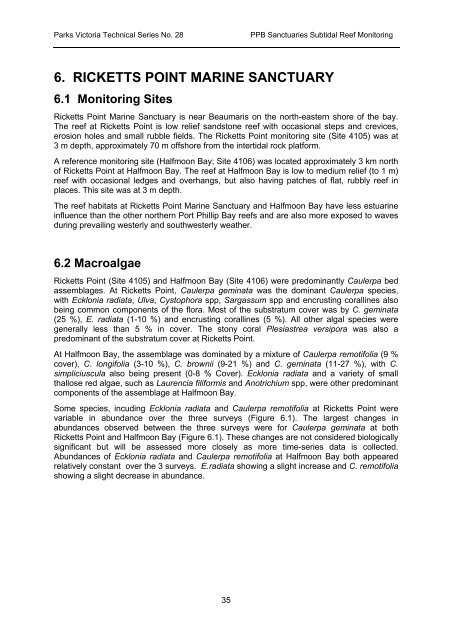Victorian Subtidal Reef Monitoring Program - Parks Victoria
Victorian Subtidal Reef Monitoring Program - Parks Victoria
Victorian Subtidal Reef Monitoring Program - Parks Victoria
Create successful ePaper yourself
Turn your PDF publications into a flip-book with our unique Google optimized e-Paper software.
<strong>Parks</strong> <strong>Victoria</strong> Technical Series No. 28PPB Sanctuaries <strong>Subtidal</strong> <strong>Reef</strong> <strong>Monitoring</strong>6. RICKETTS POINT MARINE SANCTUARY6.1 <strong>Monitoring</strong> SitesRicketts Point Marine Sanctuary is near Beaumaris on the north-eastern shore of the bay.The reef at Ricketts Point is low relief sandstone reef with occasional steps and crevices,erosion holes and small rubble fields. The Ricketts Point monitoring site (Site 4105) was at3 m depth, approximately 70 m offshore from the intertidal rock platform.A reference monitoring site (Halfmoon Bay; Site 4106) was located approximately 3 km northof Ricketts Point at Halfmoon Bay. The reef at Halfmoon Bay is low to medium relief (to 1 m)reef with occasional ledges and overhangs, but also having patches of flat, rubbly reef inplaces. This site was at 3 m depth.The reef habitats at Ricketts Point Marine Sanctuary and Halfmoon Bay have less estuarineinfluence than the other northern Port Phillip Bay reefs and are also more exposed to wavesduring prevailing westerly and southwesterly weather.6.2 MacroalgaeRicketts Point (Site 4105) and Halfmoon Bay (Site 4106) were predominantly Caulerpa bedassemblages. At Ricketts Point, Caulerpa geminata was the dominant Caulerpa species,with Ecklonia radiata, Ulva, Cystophora spp, Sargassum spp and encrusting corallines alsobeing common components of the flora. Most of the substratum cover was by C. geminata(25 %), E. radiata (1-10 %) and encrusting corallines (5 %). All other algal species weregenerally less than 5 % in cover. The stony coral Plesiastrea versipora was also apredominant of the substratum cover at Ricketts Point.At Halfmoon Bay, the assemblage was dominated by a mixture of Caulerpa remotifolia (9 %cover), C. longifolia (3-10 %), C. brownii (9-21 %) and C. geminata (11-27 %), with C.simpliciuscula also being present (0-8 % Cover). Ecklonia radiata and a variety of smallthallose red algae, such as Laurencia filiformis and Anotrichium spp, were other predominantcomponents of the assemblage at Halfmoon Bay.Some species, incuding Ecklonia radiata and Caulerpa remotifolia at Ricketts Point werevariable in abundance over the three surveys (Figure 6.1). The largest changes inabundances observed between the three surveys were for Caulerpa geminata at bothRicketts Point and Halfmoon Bay (Figure 6.1). These changes are not considered biologicallysignificant but will be assessed more closely as more time-series data is collected.Abundances of Ecklonia radiata and Caulerpa remotifolia at Halfmoon Bay both appearedrelatively constant over the 3 surveys. E.radiata showing a slight increase and C. remotifoliashowing a slight decrease in abundance.35
















